JVC KD-S757R, KD-SX858R User Manual
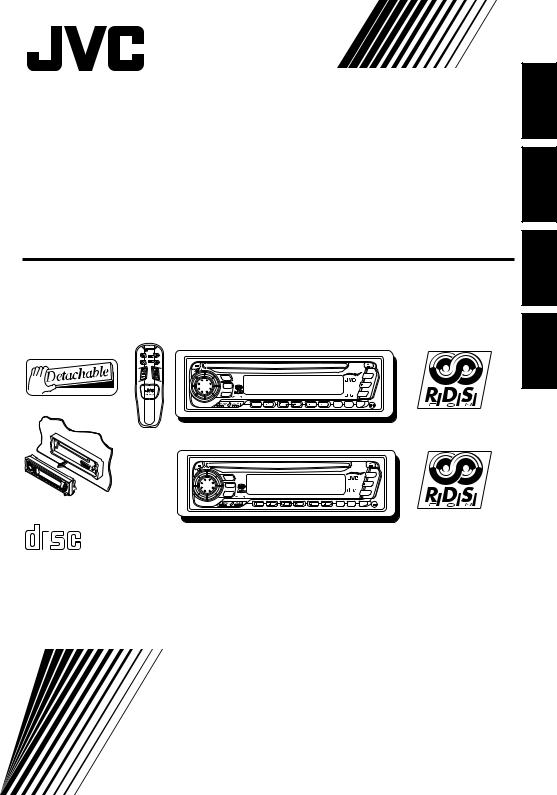
CD RECEIVER
CD-RECEIVER
RECEPTEUR CD
CD-RECEIVER
KD-SX858R/KD-S757R
KD-SX858R
ATT BAND
PROG
DISC
FUNC
DISC
PRESET
|
|
|
|
|
|
|
|
KD-SX858R |
|
|
DISP 40Wx4 |
|
|
|
|
|
|
|
C D |
|
|
|
|
|
|
|
|
|
|
SEL |
MO/RND |
|
|
|
|
|
|
CD |
FM/AM |
|
|
|
|
|
|
|
|
CHANGER |
|
|
|
|
|
|
|
|
|
CONTROL |
|
|
RPT |
|
|
|
|
|
|
|
CD-CH |
|
SSM |
7 |
8 |
9 |
10 |
11 |
12 |
|
|
|
|
|
|
|
|
|
TP |
PTY |
SOUND |
|
|
|
|
|
|
|
RDS |
||
KD-S757R
|
|
|
|
|
|
|
|
KD-S757R |
|
|
DISP 40Wx4 |
|
|
|
|
|
|
|
C D |
|
|
|
|
|
|
|
|
|
|
SEL |
MO/RND |
|
|
|
|
|
|
|
F M |
|
RPT |
|
|
|
|
|
|
|
A M |
|
SSM |
7 |
8 |
9 |
10 |
11 |
12 |
|
|
|
|
|
|
|
|
|
TP |
PTY |
SOUND |
|
|
|
|
|
|
|
RDS |
||
COMPACT
DIGITAL AUDIO
For installation and connections, refer to the separate manual.
Für den Einbau und die Anschlüsse siehe das eigenständige Handbuch. Pour l’installation et les raccordements, se référer au manuel séparé.
Bijzonderheden over de installatie en aansluiting van het apparaat vindt u in de desbetreffende handleiding.
INSTRUCTIONS
BEDIENUNGSANLEITUNG
MANUEL D’INSTRUCTIONS
GEBRUIKSAANWIJZING
NEDERLANDS FRANÇAIS DEUTSCH ENGLISH
FSUN3062-311 [E]
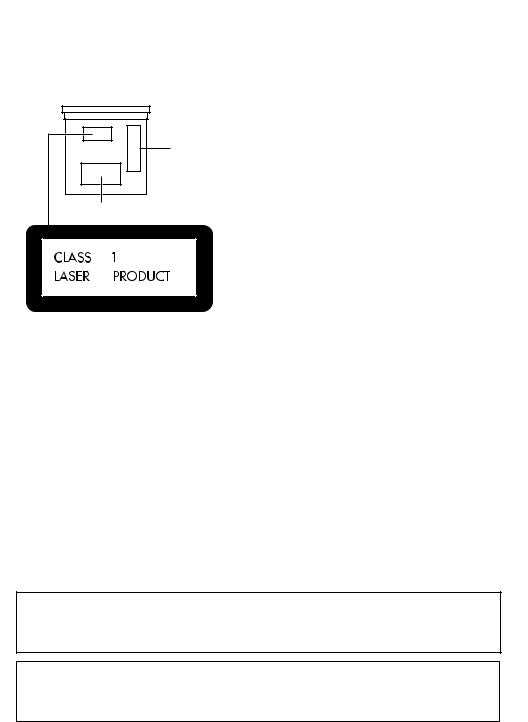
Position And Reproduction Of Labels
Bottom panel of the main unit
|
|
|
|
|
|
|
|
|
|
|
|
|
|
DANGER: Invisible |
laser |
|
ADVARSEL:Usynliglaser- |
|
VARNING:Osynliglaser- |
|
VARO: Avattaessa ja suo- |
|
|||
|
radiationwhenopen and |
|
stråling ved åbning, når |
|
strålning när denna del |
|
jalukitus ohitettaessa olet |
|
||||
|
interlock failedordefeated. |
|
sikkerhedsafbrydereerude |
|
är öppnadochspärren är |
|
alttiina näkymättömälle |
|
||||
|
AVOID DIRECT EXPOSURE |
|
af funktion.Undgåudsæt- |
|
urkopplad. Betrakta ej |
|
lasersäteilylle. Älä katso |
|
||||
|
TO BEAM. |
(e) |
|
telse for stråling. |
(d) |
|
strålen. |
(s) |
|
säteeseen. |
(f) |
|
|
|
|
|
|
|
|
|
|
|
|
|
|
Name/Rating plate
Caution:
This product contains a laser component of higher laser class than Class 1.
IMPORTANT FOR LASER PRODUCTS
Precautions:
1.CLASS 1 LASER PRODUCT
2.DANGER: Invisible laser radiation when open and interlock failed or defeated. Avoid direct exposure to beam.
3.CAUTION: Do not open the top cover. There are no user-serviceable parts inside. Leave all servicing to qualified service personnel.
4.CAUTION: This CD player uses invisible laser radiation and is equipped with safety switches to prevent radiation emission when unloading CDs. It is dangerous to defeat the safety switches.
5.CAUTION: Use of controls, adjustments or performance of procedures other than those specified herein may result in hazardous radiation exposure.
CAUTION on Volume Setting
CDs produce very little noise compared with other sources. If the volume level is adjusted for the tuner, for example, the speakers may be damaged by the sudden increase in the output level. Therefore, lower the volume before playing a disc and adjust it as required during playback.
Note:
For security reasons, a numbered ID card is provided with this unit, and the same ID number is imprinted on the unit’s chassis. Keep the card in a safe place, as it will help the authorities to identify your unit if stolen.
2
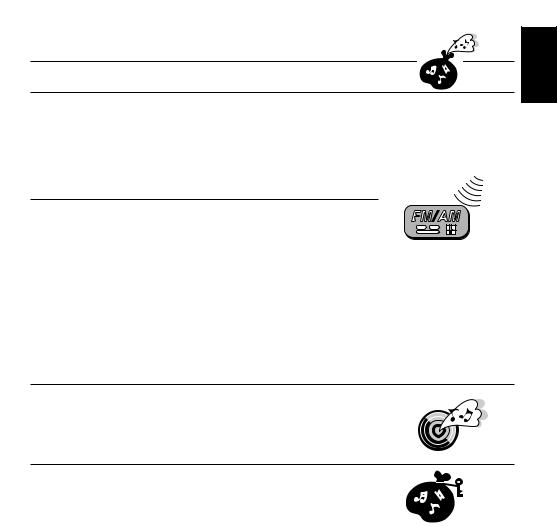
Thank you for purchasing a JVC product. Please read all instructions carefully before operation, to ensure your complete understanding and to obtain the best possible performance from the unit.
CONTENTS |
|
BASIC OPERATIONS .................................................... |
5 |
RADIO BASIC OPERATIONS ......................................... |
6 |
Listening to the radio ..................................................................... |
6 |
Storing stations in memory ............................................................ |
7 |
FM station automatic preset: SSM ............................................... |
7 |
Manual preset.............................................................................. |
8 |
Tuning into a preset station ........................................................... |
9 |
Selecting FM reception sound ....................................................... |
9 |
RDS OPERATIONS ..................................................... |
10 |
What you can do with RDS EON ................................................ |
10 |
Tracing the same programme automatically (Network-Tracking |
|
Reception) ................................................................................. |
10 |
Using Standby Reception .......................................................... |
12 |
Selecting Your Favorite Programme for PTY Standby Reception .. |
13 |
Searching Your Favorite Programme.......................................... |
13 |
Other convenient RDS functions ................................................. |
16 |
Automatic selection of the station when using the number |
|
buttons ....................................................................................... |
16 |
Changing the display mode while listening to an FM station ..... |
16 |
Setting the TA volume level ........................................................ |
16 |
Automatic clock adjustment ....................................................... |
17 |
CD OPERATIONS....................................................... |
18 |
Playing a CD ................................................................................. |
18 |
Locating a track or a particular portion on a CD ..................... |
19 |
Selecting CD playback modes ...................................................... |
20 |
Prohibiting CD ejection ............................................................... |
21 |
SOUND ADJUSTMENTS ............................................. |
22 |
Selecting preset sound control modes ......................................... |
22 |
Adjusting the sound ...................................................................... |
23 |
Storing your own sound adjustments ......................................... |
24 |
ENGLISH
CONTINUED TO THE NEXT PAGE
3
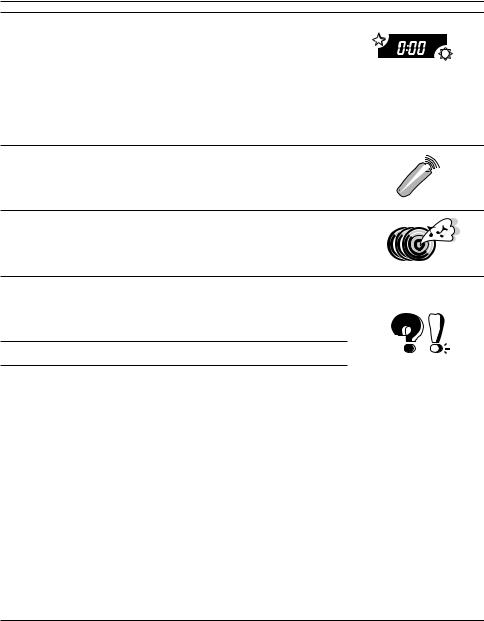
OTHER MAIN FUNCTIONS ......................................... |
25 |
Setting the clock ............................................................................ |
25 |
Changing the general settings...................................................... |
27 |
Selecting 24-hour or 12-hour clock ............................................ |
28 |
Selecting the level display ......................................................... |
29 |
Selecting the display mode while using the CD changer |
|
(ONLY FOR KD-SX858R) ......................................................... |
29 |
Selecting the telephone muting (ONLY FOR KD-SX858R) ....... |
29 |
Detaching the control panel ......................................................... |
30 |
REMOTE OPERATIONS............................................... |
31 |
(ONLY FOR KD-SX858R) |
|
Installing the batteries .................................................................. |
31 |
Using the remote controller ......................................................... |
31 |
CD CHANGER OPERATIONS ...................................... |
32 |
(ONLY FOR KD-SX858R) |
|
Playing CDs ................................................................................... |
32 |
Selecting CD playback modes...................................................... |
34 |
MAINTENANCE......................................................... |
35 |
Handling Discs .............................................................................. |
35 |
Taking care of CDs .................................................................... |
35 |
Moisture condensation .............................................................. |
35 |
TROUBLESHOOTING ................................................. |
36 |
SPECIFICATIONS ....................................................... |
37 |
BEFORE USE
* For safety....
•Do not raise the volume level too much, as this will block outside sounds, making driving dangerous.
•Stop the car before performing any complicated operations.
*Temperature inside the car....
If you have parked the car for a long time in hot or cold weather, wait until the temperature in the car becomes normal before operating the unit.
4
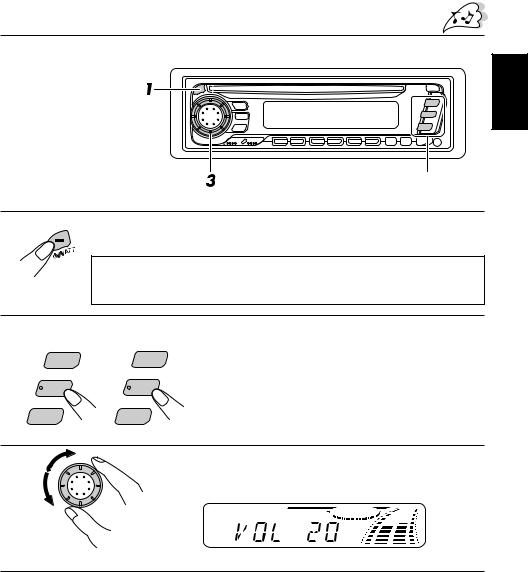
BASIC OPERATIONS
ENGLISH
Note:
When you use this unit for the
first time, set the built-in 2 clock correctly, see page 25.
1 |
Turn on the power. |
Note on One-Touch Operation:
When you select a source in step 2 below, the power automatically comes on.
You do not have to press this button to turn on the power.
2 KD-SX858R |
KD-S757R |
C D |
C D |
FM/AM |
F M |
CD-CH |
A M |
Select the source.
To operate the tuner, see pages 6 – 17.
To operate the CD player, see pages 18 – 21.
To operate the CD changer, see pages 32 – 34. (ONLY FOR KD-SX858R)
3 |
Adjust the volume. |
|
SEL |
|
Volume level appears. |
4
Adjust the sound as you want (see pages 22 – 24).
To drop the volume in a moment
Press 


 briefly while listening to any source. “ATT” starts flashing on the display, and the volume level will drop in a moment.
briefly while listening to any source. “ATT” starts flashing on the display, and the volume level will drop in a moment.
To resume the previous volume level, press the button briefly again.
To turn off the power
Press and hold 


 for more than 1 second.
for more than 1 second.
5
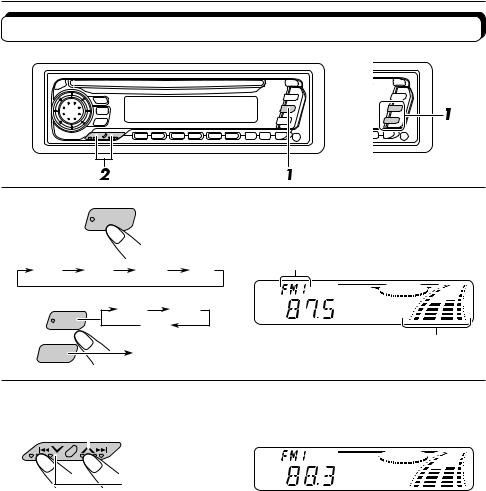

 RADIO BASIC OPERATIONS
RADIO BASIC OPERATIONS
Listening to the radio
KD-SX858R |
KD-S757R |
COMPACT
DIGITAL AUDIO
1 KD-SX858R
FM/AM |
Select the band (FM1, FM2, FM3 or AM). |
You can select any one of FM1, FM2, and FM3 to listen to an
|
|
FM station. |
Selected band appears. |
|
FM1 FM2 |
FM3 |
AM |
||
|
||||
KD-S757R |
FM1 |
FM2 |
|
|
F M |
|
|||
FM3 |
|
|
||
|
|
|
||
|
AM |
|
Audio level indicator |
|
A M |
|
(See page 29.) |
2 |
|
To search stations |
Start searching a station. |
|
|
||
|
|
of higher |
When a station is received, searching stops. |
|
|
frequencies. |
|
|
|
|
|
|
|
|
|
To search stations of lower frequencies.
To stop searching before a station is received, press the same button you have pressed for searching.
To tune in a particular frequency without searching
1 Select the band (FM or AM).
For KD-SX858R: Press FM/AM repeatedly.
For KD-S757R: Press FM or AM.
2 Press and hold  ¢or 4
¢or 4 until “M” (for Manual) starts flashing on the display. Now you can manually change the frequency while “M” is flashing.
until “M” (for Manual) starts flashing on the display. Now you can manually change the frequency while “M” is flashing.
3 Press  ¢ or 4
¢ or 4 repeatedly until the frequency you want is reached.
repeatedly until the frequency you want is reached.
•If you hold down the button, the frequency keeps changing (in 50 kHz intervals for FM and 9kHz intervals for AM–MW/LW) until you release the button.
6
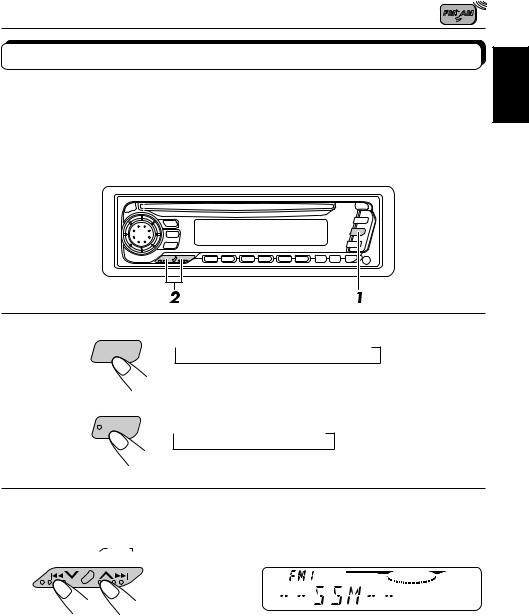
Storing stations in memory
You can use one of the following two methods to store broadcasting stations in memory.
•Automatic preset of FM stations: SSM (Strong-station Sequential Memory)
•Manual preset of both FM and AM stations
FM station automatic preset: SSM
You can preset 6 local FM stations in each FM band (FM1, FM2 and FM3).
ENGLISH
1 KD-SX858R
 FM/AM
FM/AM
KD-S757R
F M
 FM1
FM1 FM2
FM2 FM3
FM3  AM
AM
Select the FM band number (FM1, FM2 or FM3) you want to store FM stations into.
 FM1
FM1 FM2
FM2  FM3
FM3
2
SSM
Press and hold both buttons for more than 2 seconds.
“SSM” appears, then disappears when automatic preset is over.
Local FM stations with the strongest signals are searched and stored automatically in the band number you have selected (FM1, FM2 or FM3). These stations are preset in the number buttons — No. 1 (lowest frequency) to No. 6 (highest frequency).
When automatic preset is over, the station stored in number button 1 will be automatically
tuned in.
7
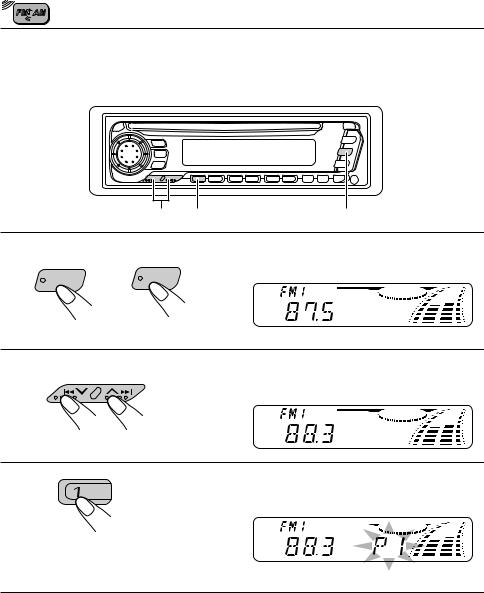
Manual preset
You can preset up to 6 stations in each band (FM1, FM2, FM3 and AM) manually. EXAMPLE: Storing an FM station of 88.3 MHz into the preset number 1 of the FM1 band
2 |
3 |
1 |
1 KD-SX858R |
KD-S757R |
FM/AM |
F M |
Select the FM1 band.
2
3
Tune into a station of 88.3 MHz.
See page 6 to tune into a station.
Press and hold the number button (in this example, 1) for more than 2 seconds.
“P1” flashes for a few seconds.
4 Repeat the above procedure to store other stations into other preset numbers.
Notes:
•A previously preset station is erased when a new station is stored in the same preset number.
•Preset stations are erased when the power supply to the memory circuit is interrupted (for example, during battery replacement). If this occurs, preset the stations again.
8
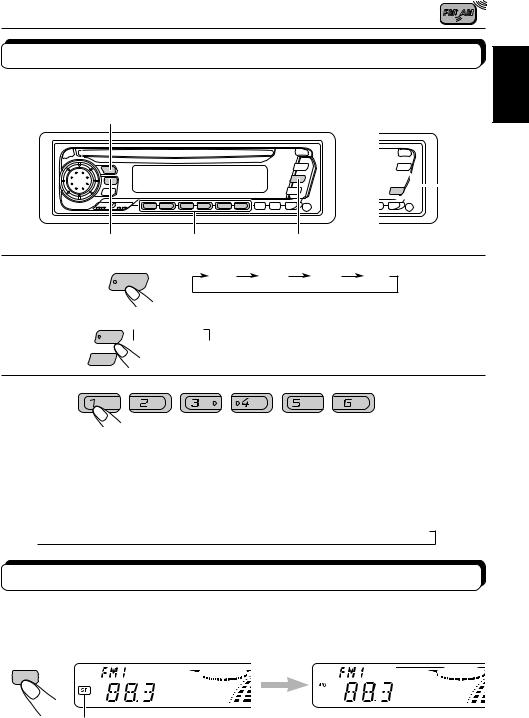
Tuning into a preset station
You can easily tune into a preset station.
Remember that you must store stations first. If you have not stored them yet, see pages 7 and 8.
KD-SX858R |
|
DISP |
KD-S757R |
|
|
|
 1
1
MO/RND |
2 |
1 |
1 KD-SX858R FM/AM |
|
FM1 FM2 FM3 AM |
Select the band (FM1, FM2, FM3
KD-S757R
 FM1
FM1 FM2 or AM) you want.
FM2 or AM) you want.
F M 
 FM3
FM3
A M  AM
AM
2
ENGLISH
Select the number (1 – 6) for the preset station you want.
To change the display information while receiving an FM RDS station
Press DISP. Each time you press the button, the display changes as follows:

 Station name
Station name  Frequency
Frequency  PTY (Programme type)
PTY (Programme type)  Clock time
Clock time
Selecting FM reception sound
When an FM stereo broadcast is hard to receive:
Press MO/RND (Mono/Random) while listening to an FM stereo broadcast. The MO (Mono) indicator lights up on the display and the sound you hear becomes monaural but reception will be improved.
MO/RND
Lights up when receiving an FM broadcast in stereo.
To restore the stereo effect, press the same button again.
9


 RDS OPERATIONS
RDS OPERATIONS
What you can do with RDS EON
RDS (Radio Data System) allows FM stations to send an additional signal along with their regular programme signals. For example, the stations send their station names, as well as information about what type of programme they broadcast, such as sports or music, etc.
Another advantage of RDS function is called “EON (Enhanced Other Networks).” The EON indicator lights up while receiving an FM station with the EON data. By using the EON data sent from a station, you can tune into a different station of a different network broadcasting your favorite programme or traffic announcement while listening to another programme or to another source such as CD.
By receiving the RDS signals, this unit can do the following:
•Tracing the same programme automatically (Network-Tracking Reception)
•Standby Reception of TA (Traffic Announcement) or your favorite programme
•PTY (Programme Type) search
•TA (Traffic Announcement) search
•And some other functions
Tracing the same programme automatically (NetworkTracking Reception)
When driving in an area where FM reception is not good, the tuner built in this unit automatically tunes in another RDS station, broadcasting the same programme with stronger signals. So, you can continue to listen to the same programme in its finest reception, no matter where you drive. (See the illustration on the next page.)
Two types of the RDS signals are used to make Network-Tracking Reception work correctly
— PI (Programme Identification) and AF (Alternative Frequency) data.
Without receiving these data correctly from the RDS station you are listening to, NetworkTracking Reception will not operate.
TP
RDS
To use Network-Tracking Reception, press and hold TP/RDS (Traffic Programme/Radio Data System) for more than 1 second. Each time you press and hold the button, Network-Tracking Reception modes change as follows:
 Mode 1
Mode 1  Mode 2
Mode 2  Mode 3
Mode 3
10
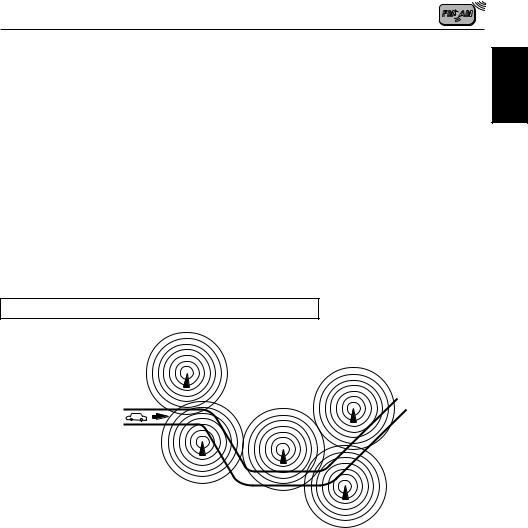
Mode 1 (AF:on / REG:off)
Network-Tracking is activated with Regionalization set to “off.”
Switches to another station within the same network when the receiving signals from the current station become weak.
Note:
In this mode, the programme may differ from the one currently received.
Mode 2 (AF:on / REG:on)
Network-Tracking is activated with Regionalization set to “on.”
Switches to another station, within the same network, broadcasting the same programme when the receiving signals from the current station become weak.
Mode 3 (AF:off / REG:off)
Network-Tracking is deactivated.
ENGLISH
The same programme can be received on different frequencies.
Programme 1 broadcasting on frequency E
Programme 1 broadcasting on frequency A
Programme 1 broadcasting on frequency B
Programme 1 broadcasting on frequency C
Programme 1 broadcasting on frequency D
11

Using Standby Reception
Standby Reception allows the unit to switch temporarily to your favorite programme (PTY: Programme Type) and Traffic Announcement (TA) from the current source (another FM station and CD).
Note:
Standby Reception will not work if you are listening to an AM station.
TA Standby Reception
TP
RDS
•When you press TP/RDS while listening to an FM station, the TP indicator is lit during reception of a TP (Traffic Programme) station and the TA standby mode is engaged.
Note:
When the station being received is not a TP station, the TP indicator flashes. Press  ¢ or 4
¢ or 4 to engage the TA standby mode. “SEARCH” appears on the display, and TP station search starts. When a TP station is tuned in, the TP indicator
to engage the TA standby mode. “SEARCH” appears on the display, and TP station search starts. When a TP station is tuned in, the TP indicator
is lit.
•If you are listening to a CD, and wish to listen to a TP station, press TP/RDS to enter the TA standby mode. (The TP indicator lights up.)
If a traffic programme starts broadcasting while the TA standby mode is active, “TRAFFIC” appears and the playback source changes to the FM band. The volume increases to the preset TA volume level and the traffic programme can be heard (see page 16).
To deactivate the TA standby mode, press TP/RDS again.
PTY Standby Reception
PTY
•When you press PTY while listening to an FM station, the PTY indicator is lit during reception of a PTY station and the PTY standby mode is engaged. The selected PTY name stored on page 13 flashes for 5 seconds.
Note:
When the station being received is not a PTY station, the PTY indicator flashes. Press  ¢or 4
¢or 4 to engage the PTY standby mode. “SEARCH” appears on the display, and PTY station search starts. When a PTY station is tuned in, the PTY indicator is lit.
to engage the PTY standby mode. “SEARCH” appears on the display, and PTY station search starts. When a PTY station is tuned in, the PTY indicator is lit.
•If you are listening to a CD, and wish to listen to a selected PTY broadcast, press PTY to enter the PTY standby mode. (The PTY indicator lights up.)
If the selected PTY programme starts broadcasting while the PTY standby mode is active, the selected PTY name appears and the playback source changes to the FM band. The selected PTY programme can then be heard.
To deactivate the PTY standby mode, press PTY again.
12

Selecting Your Favorite Programme for PTY Standby Reception
You can select your favorite programme for PTY Standby Reception to store in memory. When shipped from the factory, “NEWS” is stored as the programme type for PTY Standby Reception.
3 |
|
1, 4 |
2 |
1 |
Press and hold the button for more than 2 |
SEL |
seconds to call up the general settings mode (see page 27).
ENGLISH
2
Select “PTY STBY(Standby)” if not shown on the display.
3
Select one of twenty-nine PTY codes. (See
SEL
the table on page 17.)
Selected code name appears on the display and is stored into memory.
4
Finish setting.
Searching Your Favorite Programme
You can search one of your 6 favorite programme types stored in memory.
When shipped from the factory, the following 6 programme types have been stored in the number buttons (1 to 6).
To change the factory preset settings, see page 14. To search your favorite programme, see page 15.
1 |
2 |
3 |
4 |
5 |
6 |
POP M |
ROCK M |
EASY M |
CLASSICS |
AFFAIRS |
VARIED |
13

To store your favorite programme types
3
1, 5 |
2 |
4 |
1
SEL
Press and hold the button for more than 2 seconds to call up the general settings mode (see page 27).
2
Select “PTY SRCH(Search)” if not shown on the display.
3
SEL
Select one of twenty-nine PTY codes. (See the table on page 17.)
Selected code name appears on the display.
•If the code already stored in memory is selected, it will flash on the display.
4
Press and hold the number button for more than 2 seconds to store the PTY code selected into the preset number you want.
The PTY code starts flashing.
5
Finish setting.
14
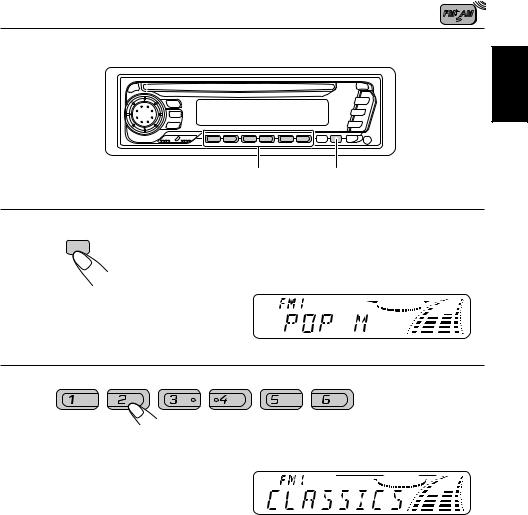
To search your favorite programme type
ENGLISH
2 1
1
PTY |
Press and hold the button for more than 1 |
|
second while listening to an FM station. |
The last selected PTY code appears.
2
Select one of the PTY codes stored in the preset number buttons (1 to 6).
Ex. When “CLASSICS” is stored in the preset number button 2.
PTY search for your favorite programme starts after 5 seconds.
•If there is a station broadcasting a programme of the same PTY code you have selected, that station is tuned in.
•If there is no station broadcasting a programme of the same PTY code you have selected, the station will not change.
Note:
In some areas, the PTY search will not work correctly.
15
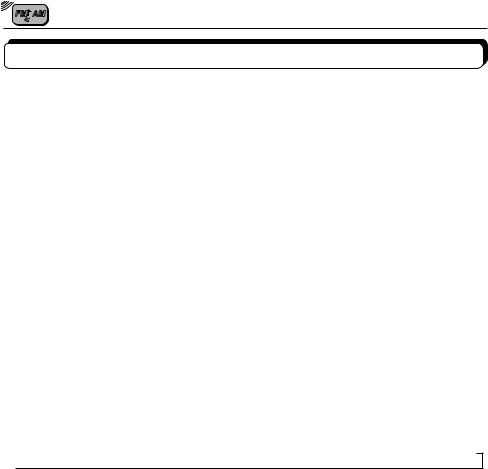
Other convenient RDS functions
Automatic selection of the station when using the number buttons
Usually when you press the number button, the preset station is tuned in.
However, when the preset station is an RDS station, something different will happen. If the signals from that preset station are not sufficient for good reception, this unit starts searching another station broadcasting the same programme as the original preset station is broadcasting, then if any station broadcasting the same programme is found, the station will be tuned in.
Changing the display mode while listening to an FM station
You can change the initial indication on the display to station frequency, station name (PS), or clock time while listening to an FM RDS station.
• See also “Changing the general settings” on page 27.
1.Press and hold SEL (select) for more than 2 seconds to call up the general settings mode.
2.Select “DISPMODE” with  ¢ or 4
¢ or 4 .
.
3.Set to the desired indication (station name, station frequency or clock time) with the control dial.
Note:
By pressing DISP, you can also change the display while listening to an FM RDS station.
Each time you press the button, the display changes to show the following:

 Station name
Station name  Frequency
Frequency  PTY (Programme type)
PTY (Programme type)  Clock time
Clock time
* The display returns to the initially preset mode after a short while.
Setting the TA volume level
You can preset the volume level for TA Standby Reception. When a traffic programme is received, the volume level automatically changes to the preset level.
• See also “Changing the general settings” on page 27.
1.Press and hold SEL (select) for more than 2 seconds to call up the general settings mode.
2.Select “TA VOL” with  ¢or 4
¢or 4 .
.
3.Set to the desired volume level with the control dial.
16

Automatic clock adjustment
When shipped from the factory, the clock built in this unit is set to be readjusted automatically using the CT (Clock Time) data in the RDS signal.
If you do not want to use automatic clock adjustment, follow the procedure below.
• See also “Changing the general settings” on page 27.
1.Press and hold SEL (select) for more than 2 seconds to call up the general settings mode.
2.Select “AUTO ADJ” with  ¢ or 4
¢ or 4 .
.
3.Select “ADJ OFF” by turning the control dial counterclockwise. Now automatic clock adjustment is canceled.
To reactivate clock adjustment, repeat the same procedure and select “ADJ ON” in step 3 by turning the control dial clockwise.
Note:
It takes about 2 minutes to adjust the time using the CT data. So, you must tune to the station for more than 2 minutes continuously; otherwise, the clock time will not be adjusted.
PTY codes
NEWS: |
News |
AFFAIRS: |
Topical programmes |
|
expanding on current news |
|
or affairs |
INFO: |
Programmes which impart |
|
advice on a wide variety of |
|
topics |
SPORT: |
Sport events |
EDUCATE: |
Educational programmes |
DRAMA: |
Radio plays |
CULTURE: |
Programmes on national or |
|
regional culture |
SCIENCE: |
Programmes on natural |
|
science and technology |
VARIED: |
Other programmes like |
|
comedies or ceremonies |
POP M: |
Pop music |
ROCK M: |
Rock music |
EASY M: |
Easy-listening music |
LIGHT M: |
Light music |
CLASSICS: |
Classical music |
OTHER M: |
Other music |
WEATHER: |
Weather information |
FINANCE: |
Reports on commerce, |
|
trading, the Stock Market, |
|
etc. |
CHILDREN: |
Entertainment programmes |
|
for children |
SOCIAL: |
Programmes on social |
|
activities |
RELIGION: |
Programmes dealing with |
|
any aspect of belief or faith, |
|
or the nature of existence or |
|
ethics |
PHONE IN: |
Programmes where people |
|
can express their views |
|
either by phone or in a |
|
public forum |
TRAVEL: |
Programmes about travel |
|
destinations, package tours, |
|
and travel ideas and |
|
opportunities |
LEISURE: |
Programmes concerned with |
|
recreational activities such |
|
as gardening, cooking, |
|
fishing, etc. |
JAZZ: |
Jazz music |
COUNTRY: |
Country music |
NATION M: |
Current popular music from |
|
another nation or region, in |
|
that country’s language |
OLDIES: |
Classic pop music |
FOLK M: |
Folk music |
DOCUMENT: Programmes dealing with factual matters, presented in an investigative style
ENGLISH
17
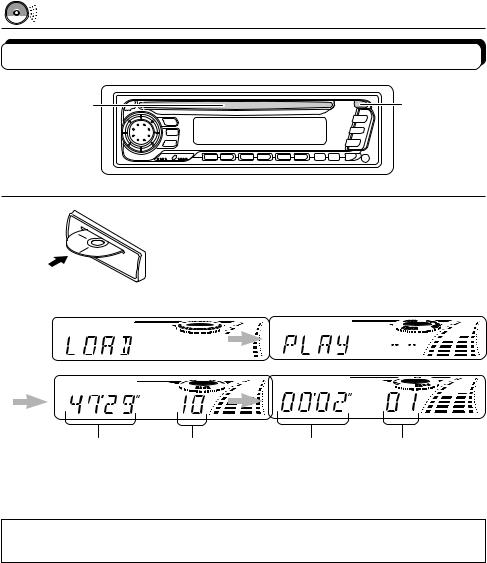
CD OPERATIONS
Playing a CD
Loading slot |
0 |
Insert a disc into the loading slot.
The unit turns on, draws a CD and starts playback automatically.
|
|
|
|
|
|
|
|
|
|
|
|
|
|
|
|
|
|
|
|
|
|
|
|
|
|
|
Total playing time of |
Total track number of |
Elapsed |
Current track |
|
|
|||
|
|
|||||||
the inserted disc |
the inserted disc |
playing time |
|
|
|
|
||
Note:
When a CD is inserted upside down, “EJECT” appears on the display and the CD ejects automatically.
Note on One-Touch Operation:
When a CD is already in the loading slot, pressing CD turns on the unit and starts playback automatically.
To stop play and eject the CD
Press 0.
CD play stops and the CD automatically ejects from the loading slot.
If you change the source to FM or AM (or CD changer: ONLY FOR KD-SX858R), the CD play also stops (without ejecting the CD this time).
Notes:
•If the ejected disc is not removed for about 15 seconds, the disc is automatically inserted again into the loading slot to protect it from dust. (CD play will not start this time.)
•You can eject the CD even when the unit is turned off.
18
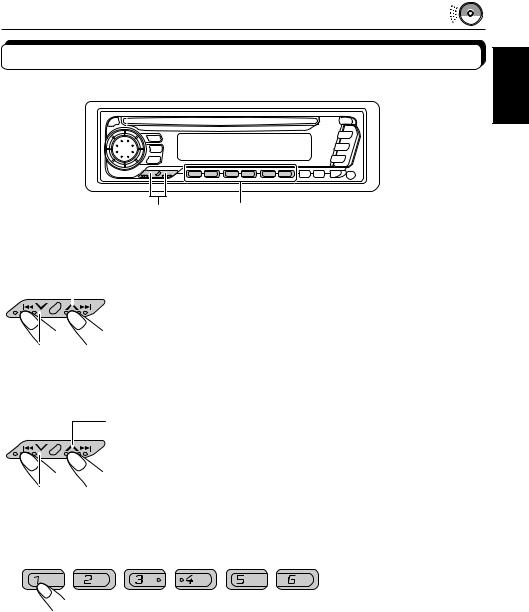
Locating a track or a particular portion on a CD
ENGLISH
 ¢ Number buttons
¢ Number buttons
4
To fast forward or reverse the track
 Press and hold
Press and hold  ¢, while playing a CD, to fast forward the track.
¢, while playing a CD, to fast forward the track.
 Press and hold 4
Press and hold 4 , while playing a CD, to reverse the track.
, while playing a CD, to reverse the track.
To go to the next track or the previous track
Press  ¢briefly, while playing a CD, to go ahead to the beginning of the next track.Each time you press the button consecutively, the beginning of the next track is located and played back.
¢briefly, while playing a CD, to go ahead to the beginning of the next track.Each time you press the button consecutively, the beginning of the next track is located and played back.
Press 4 briefly, while playing a CD, to go back to the beginning of
briefly, while playing a CD, to go back to the beginning of  the current track. Each time you press the button consecutively, the beginning of the previous track is located and played back.
the current track. Each time you press the button consecutively, the beginning of the previous track is located and played back.
To go to a particular track directly
7 8 9 10 11 12
Press the number button corresponding to the track number to start playback.
•To select a track number from 1 – 6: Press 1 (7) – 6 (12) briefly.
•To select a track number from 7 – 12:
Press and hold 1 (7) – 6 (12) for more than 1 second.
19
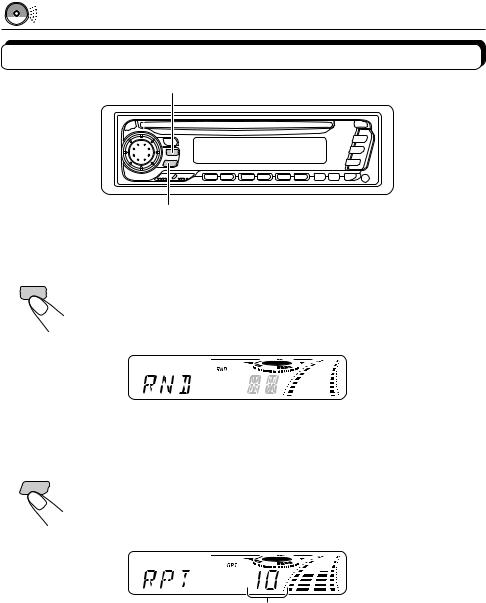
Selecting CD playback modes
MO/RND
RPT
To play back tracks at random (Random Play)
You can play back all tracks on the CD at random.
Each time you press MO/RND (Mono/Random) while playing a CD, CD
MO/RND
random play mode turns on and off alternately.
When the random mode is turned on, the RND indicator lights up on the display and a track randomly selected starts playing.
• To select the next track at random, press  ¢ briefly.
¢ briefly.
To play back tracks repeatedly (Repeat Play)
RPT
You can play back the current track repeatedly.
Each time you press RPT (Repeat) while playing a CD, CD repeat play mode turns on and off alternately.
When the repeat mode is turned on, the RPT indicator lights up on the display.
Track number of the currently playing track
20
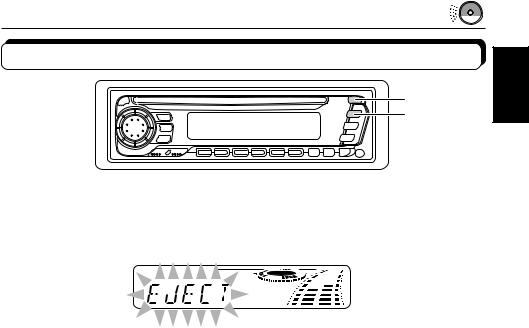
Prohibiting CD ejection
0
CD
You can prohibit CD ejection and can “lock” a CD in the loading slot.
While pressing CD, press 0 for more than 2 seconds. “EJECT” flashes on the display for about 5 seconds, and the CD is “locked” and cannot be ejected.
To cancel the prohibition and “unlock” the CD, press and hold 0again for more than 2 seconds, while pressing CD. “EJECT” appears on the display, and the CD ejects from the loading slot.
ENGLISH
21
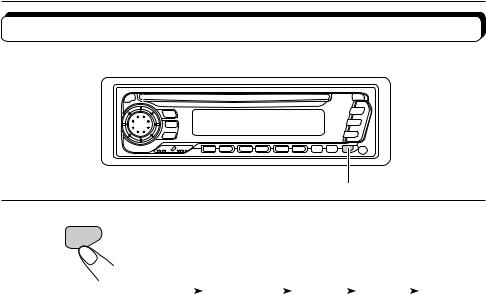
 SOUND ADJUSTMENTS
SOUND ADJUSTMENTS
Selecting preset sound control modes
You can select a preset sound adjustment suitable to the music genre.
SOUND
SOUND Call up the sound control mode you want.
Each time you press the button, the sound control mode (SCM) changes as follows:
|
|
|
SCM OFF |
|
|
BEAT |
|
|
SOFT |
|
|
POP |
|
|
||
|
|
|
|
|
|
|
|
|
|
|
||||||
|
|
|
|
|
|
|
|
|
|
|
|
|
|
|
|
|
|
|
|
|
|
|
|
|
|
|
|
|
|
|
|
|
|
Indication |
For: |
|
|
|
|
|
Preset values |
|||||||||
|
|
|
|
|
|
|
|
|
|
|
|
|
|
|
|
|
|
|
|
|
Bass |
|
|
|
Treble |
|
Loudness |
||||||
|
|
|
|
|
|
|
|
|
|
|
|
|
|
|
|
|
SCM OFF |
(Flat sound) |
00 |
|
|
|
00 |
|
|
On |
|||||||
|
|
|
|
|
|
|
|
|
|
|
|
|
|
|
|
|
BEAT |
Rock or disco music |
+2 |
|
|
|
00 |
|
|
On |
|||||||
|
|
|
|
|
|
|
|
|
|
|
|
|
|
|
|
|
SOFT |
Quiet background music |
+1 |
|
|
|
|
|
–3 |
|
|
Off |
|||||
|
|
|
|
|
|
|
|
|
|
|
|
|
|
|
|
|
POP |
Light music |
+4 |
|
|
|
+1 |
|
|
Off |
|||||||
|
|
|
|
|
|
|
|
|
|
|
|
|
|
|
|
|
Notes:
• You can adjust the preset sound control mode to your preference, and store it in memory.
If you want to adjust and store your original sound control mode, see “Storing your own sound adjustments” on page 24.
• To adjust only the bass and treble reinforcement levels to your preference, see “Adjusting the sound” on page 23.
22
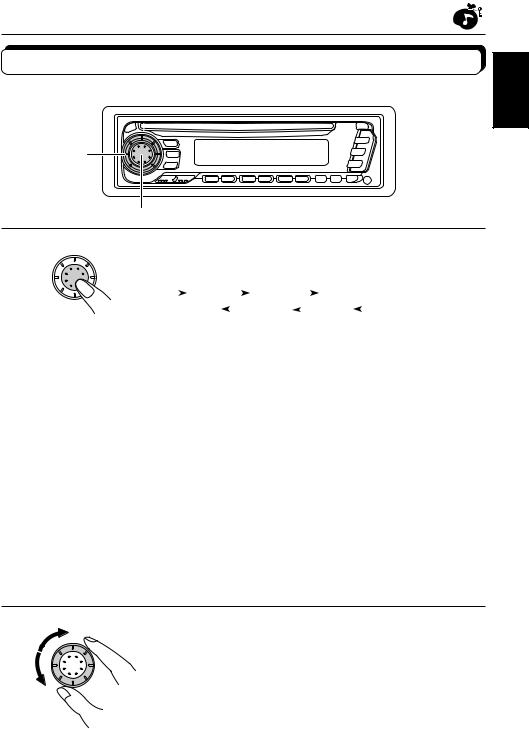
Adjusting the sound
You can adjust the sound characteristics to your preference.
2
1
1
Select the item you want to adjust.
SEL
|
|
|
|
BAS |
|
|
|
TRE |
|
|
|
|
FAD |
|
|
|
|
|
|
|
|
|
|
|
|
|
|
|
|
|
|||
|
|
|
|
VOL |
|
|
|
LOUD |
|
|
|
BAL |
|
|
||
|
|
|
|
|
|
|
|
|
|
|
|
|||||
|
|
|
|
|
|
|
|
|
|
|
|
|
|
|
|
|
Indication |
To do: |
|
|
|
|
|
|
|
|
|
|
|
Range |
|||
|
|
|
|
|
|
|
|
|
|
|
|
|
|
|
|
|
BAS |
Adjust the bass. |
|
|
|
|
|
|
–6 (min.) — +6 (max.) |
||||||||
|
|
|
|
|
|
|
|
|
|
|
|
|
|
|
|
|
TRE |
Adjust the treble. |
|
|
|
|
|
|
–6 (min.) — +6 (max.) |
||||||||
FAD* |
Adjust the front and rear speaker |
R6 (rear only) — F6 (front only) |
||||||||||||||
|
balance. |
|
|
|
|
|
|
|
|
|
|
|
|
|||
|
|
|
|
|
|
|
|
|
|
|
|
|
|
|
|
|
BAL |
Adjust the left and right speaker |
L6 (left only) — R6 (right only) |
||||||||||||||
|
balance. |
|
|
|
|
|
|
|
|
|
|
|
|
|||
LOUD |
Boost low and high frequencies to |
LOUD ON — LOUD OFF |
||||||||||||||
|
produce a well-balanced sound at low |
|
|
|
|
|
|
|||||||||
|
volume level. |
|
|
|
|
|
|
|
|
|
|
|
|
|||
VOL |
Adjust the volume. |
|
|
|
|
|
|
00 (min.) — 50 (max.) |
||||||||
|
|
|
|
|
|
|
|
|
|
|
|
|
|
|
|
|
Note:
* If you are using a two-speaker system, set the fader level to “00.”
2
Adjust the level.
SEL
Note:
Normally the control dial is used to set the volume. So you do not have to select “VOL (Volume)” to adjust the volume level.
ENGLISH
23
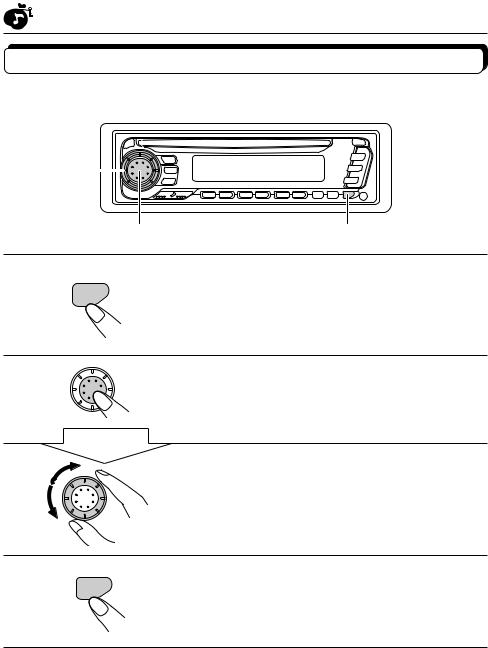
Storing your own sound adjustments
You can adjust the sound control modes (BEAT, SOFT, POP: see page 22) to your preference and store your own adjustments in memory.
1
2
3
3
2 |
1, 4 |
Call up the sound control mode you want to
SOUND
adjust.
See page 22 for details.
Select “BAS (Bass),” “TRE (Treble)” or “LOUD (Loudness).”
Within 5 seconds
|
Adjust the bass or treble level or turn the |
SEL |
loudness function ON/OFF. |
See page 23 for details.
4
SOUND |
Press and hold SOUND until the sound control |
|
mode you selected flashes on the display. |
Your setting is stored in memory.
5
Repeat the same procedure to store other settings.
To reset to the factory settings
Repeat the same procedure and reassign the preset values listed in the table on page 22.
24
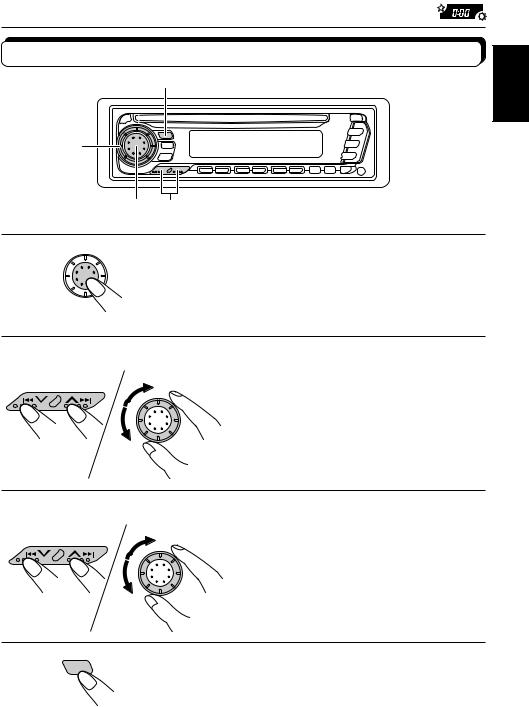
OTHER MAIN FUNCTIONS
Setting the clock
6
3, 5 |
|
|
|
|
1 |
2, 4 |
|
1 |
|
|
Press and hold the button for more than |
SEL |
|
|
|
|
|
|
2 seconds to call up the general settings |
|
|
|
mode. |
2 |
3 |
2 |
Set the hour. |
1 |
|
||
|
|
|
1 Select “CLOCK H” if not shown on |
|
|
SEL |
the display. |
|
|
|
|
|
|
|
2 Adjust the hour. |
4 |
5 |
|
Set the minute. |
1 |
|
2 |
|
1 Select “CLOCK M.”
SEL
2 Adjust the minute.
ENGLISH
6 |
DISP |
|
Start the clock. |
25
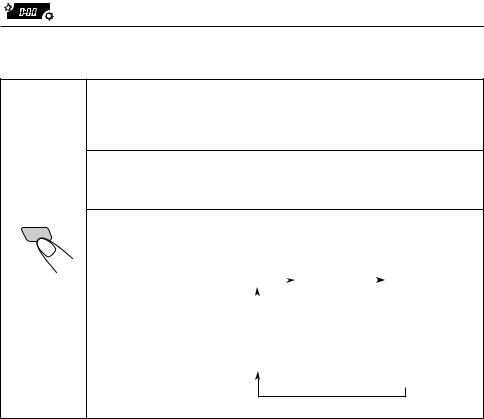
To check the current clock time
Press DISP. Each time you press the button, indications change as follows:
DISP
During tuner operation:
Clock 
 Frequency
Frequency
Note:
For the indication change during RDS operation, see page 16.
During CD operation:
Clock 
 Elapsed playing time
Elapsed playing time
During CD changer operation: (ONLY FOR KD-SX858R)
• When “DISC” is selected as the initial indication
Clock |
|
Disc |
|
Elapsed |
||
|
|
|
number |
|
playing time |
|
|
|
|||||
|
|
|
|
|
|
|
|
|
|
|
|
|
|
• When “TIME” is selected as the initial indication
Clock  Elapsed
Elapsed  Disc
Disc
playing time number
To check the current clock time while the unit is turned off, press DISP.
The power turns on, the clock time is shown for 5 seconds, then the power turns off.
26
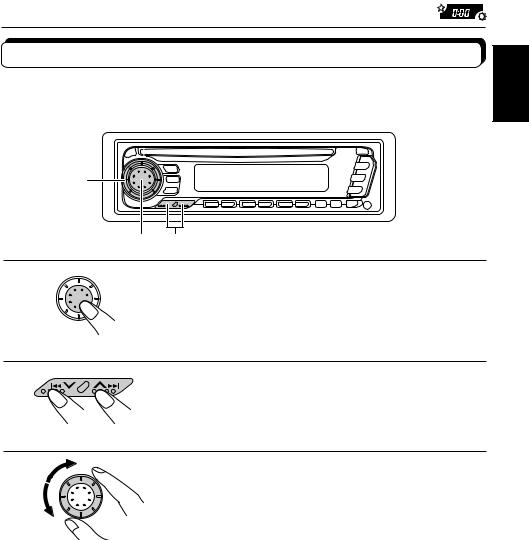
Changing the general settings
You can change the settings of the items listed on the next page.
Basic Procedure
ENGLISH
3 |
|
1 |
2 |
1 |
Press and hold the button for more than |
SEL |
|
|
2 seconds to call up the general settings |
|
mode. |
2 |
Select the item you want to adjust. |
|
|
|
(See page 28.) |
3
Select or adjust the item selected above.
SEL
27
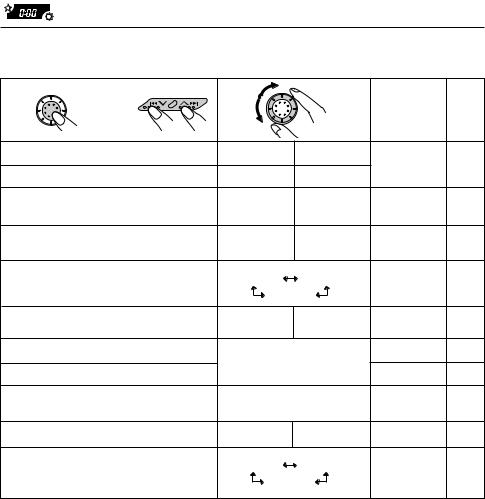
1 |
2 |
3 |
SEL |
|
Factory- |
See |
|
|
|
|
|
preset |
page |
|
|
|
|
|
settings |
|
|
Select. |
|
|
Set. |
|
|
|
|
|
|
|
||
CLOCK H |
Hour adjustment |
Back |
Advance |
0:00 |
25 |
|
CLOCK M |
Minute adjustment |
|
Back |
Advance |
||
|
|
|
||||
24H/12H |
24/12-hour time |
|
12H |
24H |
24H |
28 |
|
display |
|
||||
|
|
|
|
|
|
|
AUTO ADJ |
Automatic setting of |
ADJ OFF |
ADJ ON |
ADJ ON |
17 |
|
|
the clock |
|||||
|
|
|
|
|
|
|
DISPMODE |
Display mode |
PS NAME |
FREQ |
PS NAME |
16 |
|
|
|
|||||
|
|
|
CLOCK |
|||
|
|
|
|
|
||
CH DISP |
Changer display |
TIME |
DISC |
DISC |
29 |
|
|
(ONLY FOR KD-SX858R) |
|||||
|
|
|
|
|
|
|
PTY STBY |
PTY standby |
|
29 programme types |
NEWS |
13 |
|
|
|
|
|
|
||
PTY SRCH |
PTY search |
|
(See page 17.) |
(See page 13.) |
14 |
|
|
|
|
||||
TA VOL |
Traffic announcement |
|
VOL (00 – 50) |
VOL (20) |
16 |
|
|
volume |
|
||||
|
|
|
|
|
|
|
LEVEL |
Level display |
|
OFF |
AUDIO |
AUDIO |
29 |
TEL |
Audio mute for cellular |
OFF |
MUTING 1 |
|
|
|
|
phone system |
OFF |
29 |
|||
|
|
MUTING 2 |
||||
|
(ONLY FOR KD-SX858R) |
|
|
|
||
• Press SEL (Select) when the setting is complete.
Selecting 24-hour or 12-hour clock
You can change the clock built in this unit either to 24-hour system or 12-hour system.
1.Press and hold SEL (Select) for more than 2 seconds to call up the general settings mode.
2.Select “24H/12H” with  ¢ or 4
¢ or 4 .
.
3.Select “24H” or “12H” with the control dial.
The clock alternates between 24-hour system and 12-hour system.
24H 
 12H
12H
28

Selecting the level display
You can select the level display according to your preference. When shipped from the factory, the level indicator on the display shows the audio level setting.
• |
AUDIO: |
Audio level indicator |
• |
OFF: |
Volume level indicator |
1.Press and hold SEL (Select) for more than 2 seconds to call up the general settings mode.
2.Select “LEVEL” with  ¢ or 4
¢ or 4 .
.
3.Select “AUDIO” or “OFF” with the control dial. The level display setting changes as follows:
AUDIO 
 OFF
OFF
Selecting the display mode while using the CD changer (ONLY FOR KD-SX858R)
You can change the initial indication on the display either to disc number or to elapsed playing time, while using the CD changer.
1.Press and hold SEL (Select) for more than 2 seconds to call up the general settings mode.
2.Select “CH DISP” with  ¢ or 4
¢ or 4 .
.
3.Select “DISC” or “TIME” with the contorl dial.
DISC 
 TIME
TIME
Selecting the telephone muting (ONLY FOR KD-SX858R)
This mode is used when a cellular phone system is connected. Depending on the phone system used, select either “MUTING 1” or “MUTING 2”, whichever mutes the sounds from this unit.
When shipped from the factory, this mode is deactivated.
•MUTING 1: Select this if this setting can mute the sounds.
•MUTING 2: Select this if this setting can mute the sounds.
•OFF: Cancels the telephone muting.
1.Press and hold SEL (Select) for more than 2 seconds to call up the general settings mode.
2.Select “TEL” with  ¢ or 4
¢ or 4 .
.
3.Select “MUTING 1,” “MUTING 2” or “OFF” with the control dial. The telephone muting mode changes as follows:
 MUTING 1
MUTING 1
 MUTING 2
MUTING 2 
 OFF
OFF 
ENGLISH
29

Detaching the control panel
You can detach the control panel when leaving the car.
When detaching or attaching the control panel, be careful not to damage the connectors on the back of the control panel and on the panel holder.
How to detach the control panel
Before detaching the control panel, be sure to turn off the power.
1
Unlock the control panel.
How to attach the control panel
1
Insert the left side of the control panel into the groove on the panel holder.
2
Lift and pull the control panel out of the unit.
3
Put the detached control panel into the provided case.
2
Press the right side of the control panel to fix it to the panel holder.
Note on cleaning the connectors:
If you frequently detach the control panel, the connectors will deteriorate.
To minimize this possibility, periodically wipe the connectors with a cotton swab or cloth moistened with alcohol, being careful not to damage the connectors.
Connectors
30
